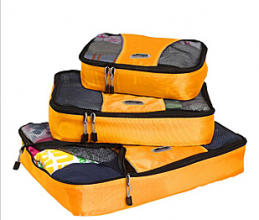I’m what you’d call a very frequent traveler. Earlier this year, I checked my mileage stats against others in my TripIt network (more on that app in a bit), and when I realized that I’d surpassed Joi Ito in miles, I knew I was out of control.

It’s taken me awhile to get things down to a science, but as I’m currently on a 6-week jaunt through seven countries and three continents, I figured now was as good of a time as ever to offer up some suggestions. So here are ten things that make my life on the road so much easier, from the must-have apps to the simplest credit card.
- TripIt – Coming in at first place is TripIt, that indispensable app that once saved me from a night in Kentucky. How, you ask? Well, I was attending an academic conference in Louisville when I learned that the first of my two flights had been delayed so as to cause me to miss the second flight. Not wanting to stay in Kentucky for even a minute longer, I called United, only to have them tell me there were no available options that night. Lucky for me, I’d recently purchased TripIt Pro (a mere $49/year, makes a great holiday gift), which offers the opportunity to check out alternative flights. So while the United rep was claiming there was nothing to be done, I was quickly seeking out alternatives, which I presented to him, and lo! The dumbfounded agent admitted I was right and quickly re-booked me through Denver to SFO that evening. Bam! Though that’s the only time TripIt has saved my ass, so to speak, I use the app with every trip to keep track of my whereabouts. Pro-tip: If your mom is like mine and always wants your itinerary, TripIt can help with that, too.
- AirBnB – I admit, after those early horror stories, I was a total skeptic. But after checking out all of Amsterdam’s hotels for THNK, I realized AirBnB might be my only affordable option. So I booked a room in someone’s house, and I was not disappointed – the company got off to a rocky start, but learned its lessons and now provides stronger insurance protections for homeowners and users, plus it’s built around a trust network, so you can rely on reviews and friend networks to find a place where you feel comfortable. I’ve now used the site in Amsterdam and Marrakech, and have suggested it to numerous friends in numerous countries as well. It’s now my preference for longer-term travel.
- The United Club Card – Though this one’s really for the most frequent of travelers (it comes with a $395 annual price tag, though it’s possible to get it waived or discounted for the first year – I got mine fully refunded just by asking), it’s been invaluable to me. Not only do you get more miles to the dollar (1.5 to be exact, and 2 on United purchases), but it also comes with United Club membership, insurance benefits (including lost/delayed luggage), and no foreign transaction fees. That, for me, was the kicker: I did the math and realized that I was paying around $200 annually on such fees, which makes the $395 annual fee seem worthwhile, when you throw in the other perks. This card’s so good, even the New York Timesreviewed it. And if you’re a less frequent traveler but still like the perks, the MileagePlus Explorer card (which I had for a year before switching to this one) is also pretty great. If United isn’t your airline, check out mileage cards for others…but if you’re just starting out collecting miles, United really does have the best deals.
- Good renter’s insurance – This was a tip that Chris Soghoian gave me way back in the day, and though I didn’t think I’d need most of the perks he mentioned, I got it anyway…and I’ve been so glad. Renter’s (or homeowner’s, as the case may be) insurance is invaluable anyway (last year, I got a theft of laundry from the laundromat covered, and just a few weeks ago, my stolen bike), but good renter’s insurance will also cover lost or delayed luggage. I have USAA, which is only accessible to those grandfathered in through military family members (in this case, a grandfather), but there are plenty of good, affordable choices available out there.
- Packing cubes – I have a frequent-traveler friend (you know who you are) whose suitcase makes me want to cry. It’s dirty shoes piled on top of clean clothes, with toiletries stuffed in between…a type A nightmare. I, on the other hand, cannot deal with a messy suitcase and so I took someone’s

I keep six of these in my suitcase advice and hooked myself up with a slew of packing cubes (I have the set previously linked, plus one of these, and these shoe bags), which has made my life so much more organized, and my suitcase so much easier to close. And speaking of suitcases…
- A good, hardshell suitcase – This is a tip I got from Robert Guerra who, despite coming in third this year for countries traveled, is a seasoned traveler whose suit never looks wrinkled. Though some may recommend top-of-the-line stuff, I feel that Samsonite’s warranty does just fine. And while even their top line suitcases can get expensive, I found a great deal on a Crusair (still available here) with latches instead of a zipper, and a built-in lock for $200. Highly recommended.
- A universal SIM – This advice doesn’t apply to you AT&T suckers, but the rest of you could benefit from it. Instead of racking up huge fees on your US mobile subscription, picking up a local SIM will save you a ton of money (note: T-Mobile will unlock your phone after 3 months of being a subscriber, but these days it’s easy to purchase an Android directly from Google or Amazon, unlocked). But if you travel a lot, you know that buying a local SIM in each country can be a bit of a pain. Personally, I’ve had the best luck with Telestial (which gives you a Euro number but also allows call forwarding from your US number), but there are plenty of others to choose from.
- A universal adapter kit – This past week, traveling with a well-traveled but relatively infrequent traveler, I watched her frustration as she tried to fit her perfectly normal Euro plug into the slightly modified Moroccan outlets. It was a small difference (the actual prongs are the same, the outlet is slightly different in shape), but one that caused frustration as we switched back and forth between charging her phone and my laptop, before finally picking up a new one in the souk. I also used to carry a couple European adapters around with me until I discovered Brookstone’s universal kit. It’s a bit pricey, but I’ve never found a country in which it doesn’t work, and I loan it out to traveling friends whenever I’m not using it. Excellent bang for your buck.
- Travel detergents – This is for those really long jaunts, like the one I’m on. While I prefer, of course, to wash stuff in a machine or have it dry cleaned, sometimes that’s just not an option. So when the need arises, I prefer to use a gentle soap rather than just buy a mini-pack of a harsh detergent like Tide, as I feel like the gentle handwashing detergents rinse out better when you don’t have a machine. My favorite (which I also use at home for handwashing) is Forever New, but I also keep a packet of these in my suitcase at all times…because you never know.
- A proper, but tiny, first-aid kit – I used to think this was frivolous, until I found out that there are countries where you can’t get Sudafed without a prescription (WTF?) Mine is hand-curated, and contains quality band-aids, DayQuil/NyQuil (read: pseudoephedrine, a total necessity for flying with a cold, to avoid painful ear pressure), all varieties of stomach-related meds, paracetemol, and one course of anti-biotics. Somewhat surprisingly, you’re usually better off finding these things in developing countries (i.e., in Morocco, all of those meds are available over the counter), but things like bandages can be of lesser quality, whereas in the Netherlands, bandages are superb but you can’t buy pseudoephedrine without a prescription.

And here are a few other, mostly somewhat feminine, things I can’t live without:
- OPI cuticle oil on-the-go: saves me from having to bother with manicures for weeks on end
- Biotherm Travel Recharge: my airplane savior
- An infinity scarf: it’s a scarf that easily doubles as a hood/hat for cold days
- I actually air dry most of the time, but when I travel (especially for fancy things), I sometimes carry this teeny-weeny hairdryer with me.
- Though mine is far less fancy/expensive, I’m never stuck without a manicure kit. Mostly for hangnails, sometimes for vanity.
6 replies on “Ten Travel Tips (from the most frequent of travelers)”
All really good tips, superwoman. And a few from this side of the pond. If you’re in the UK:
Halifax Clarity Visa Card is free (no annual fee) and charges no foreign transaction charges AND uses the Visa base rate (because some cards don’t charge a fee, but do screw you with a harsh exchange rate).
I can’t live without my little Antler Liquis suitcase. It’s a hard case, but it’s the world’s lightest (at 2kg) and lighter than many soft cases. And its dimensions are just inside the hand luggage allowances for many airlines (I stopped checking in bags after a series of Alitalia/Damascus incidents).
Totally agree about the compartmentalised packing. I’ve never needed to pack beyond my hand luggage (that means I can check in on my phone and go straght to the gate, it means I don’t have to wait on the carousel, and it means I never lose anything!). But the packing cubes is one step beyond.
And for telephones: yes, an unlocked phone is a must. And then local sims in the countries you visit (most can be bought and up and running in a few mins). This is a really good resource:
http://www.prepaidgsm.net/
If you’re in the EU, Vodafone EuroTraveller is amazing: £3 a day to use your home allowance of minutes/texts/data while you’re abroad (incoming calls are free, too). And all international calls are free. It’s a life-changer and it also means people calling me pay the usual UK price instead of international call rates.
Shout wipes or Tide pen.
I always keep a couple of safety pins in my wallet and a couple extra zip-top plastic bags in various sizes in my suitcase.
I may not be quite keeping up with y’all, but since I started using Tripit in early September, it’s clocking me in at about 16k miles. I used to use rolling luggage (semi-hard sided Tumi t3s, which served me very well at the time), but now that I spend more time not getting taxis or staying in hotels, I’ve found a backpack is a lot easier to deal with around cobblestones, through random European train stations, and up steep Dutch stairways into friend’s houses, etc. I carry a fair bit of luggage, but I also don’t have a home base, so it’s hard to get away from it. If you do decide to get a backpack, the Arc’teryx Arakis line is absolutely rock solid and waterproof. I’ve been very, very happy with mine. Sadly, you still can’t check it without more protection, so I’ve got an Osprey travel duffel it gets shoved into.
I very much second you on packing cubes. I have a rule that nothing ever gets packed directly — *everything* goes into a cube. This means that even when I’ve exploded my luggage all over a friend’s living room, I’m no more than about 20 minutes from having everything packed — it keeps me organized even outside of my bag.
If you are going to travel with a backpack, and you’re carrying a second smaller one as a carryon with your laptop, jewelery, currencies, medications, and all of those things that one never, ever, ever checks, figuring how how to not do that awkward “slipping the front pack’s straps behind your shoulders” thing is well worth it. For me, I use a pair of carabiners on the uphauls for my big backpack’s main straps, tighten down the straps of the small backpack, and just clip them through. Done right, it’s not much more load on the shoulders and it never falls off, mid-platform.
I’m sure there’s more. but that’s a start.
Great tips! I’ve always doubted about the benefits of insurance, but it seems that more and more people are recommending it.
I’d like to add a few more tips for those who are frequent bus travelers.
1) Research your bus routes thoroughly
2) Buy tickets in advance if possible
3) Bring a comfort kit (pillow, extra clothes, tissues, food, water)
If you’re traveling to a lot of foreign places by bus, check out http://www.busbud.com. It’s the most comprehensive source of information for intercity bus travelers!
Hey Jillian,
Great post. May I suggest checking out a great travel app that I developed called Airport Life.
I used my 23 years of experience as an airline pilot to create an app that makes flying easier & less stressful. It’s a multi-function app that contains all the functions a flyer needs plus many unique features like getting real-time flight updates on delays pushed to your phone. It’s available on iPhone/iPad and Android. Check out more the features here: http://www.airportlifeapp.com/features/
I think you will find it very useful for your travels!
Best
Captain Dan